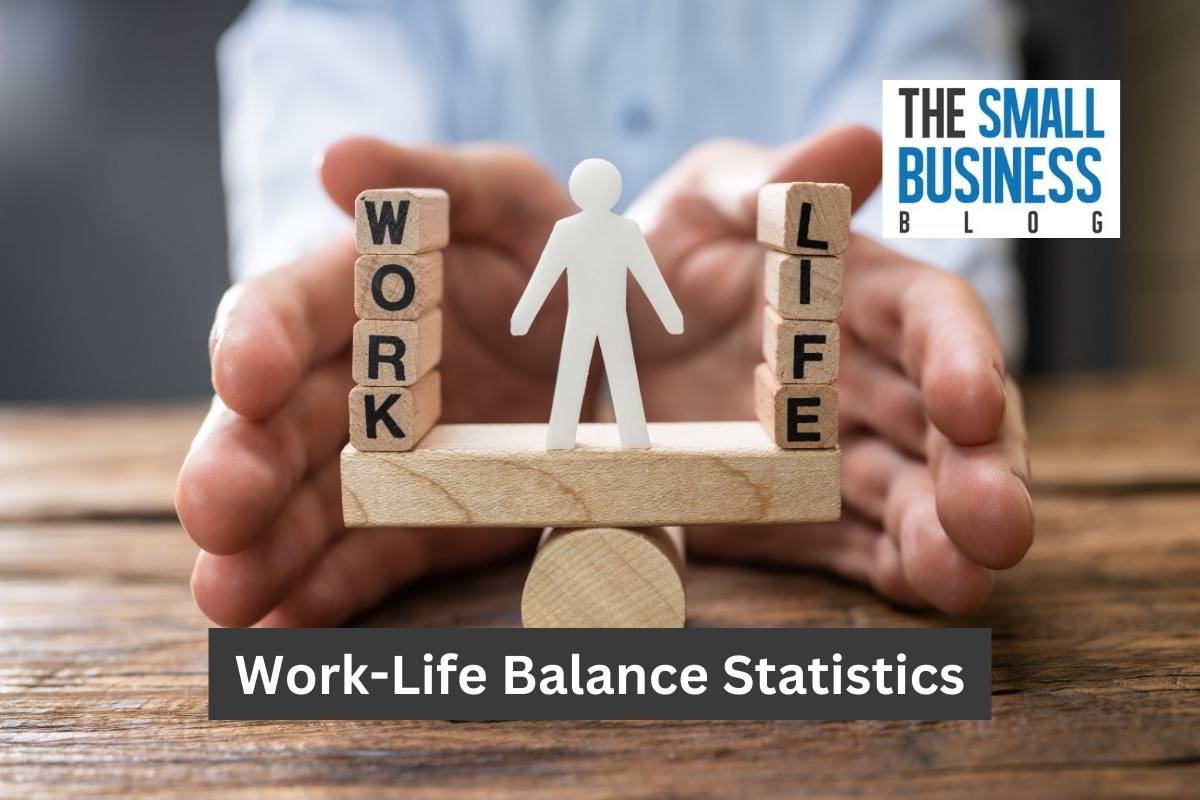Work-life balance is about the ability to divide your time and energy between your work and personal commitments in a sustainable and healthy way.
It’s an important ideal for employees and employers alike as it can have a significant effect on employee retention, work productivity, and overall well-being.
While work-life balance has always been something people should consider, awareness of this concept has been growing in recent years.
As more people seek to achieve better balance between their personal and work lives, the demand for employers to offer better work-life balance is more important.
The growing demand for work-life balance is believed to be due to several factors such as the rise in remote work, the increasing demands in the workplace, and the growing awareness of the importance of mental health.
In this article, we will discuss the work-life balance statistics that everyone needs to know.
Knowing the data can help you to make the appropriate changes to improve your own work-life balance.
It can even help employers better understand the concept of making changes in the workplace.
Let’s discuss work-life balance.
Post Contents
- 1 Key Statistics
- 2 Top Work-Life Balance Statistics in 2024
- 2.1 1. 72% of workers think that work-life balance is a vital factor in job selection.
- 2.2 2. New Zealand’s “life-work” balance score is the highest in the world at 79.35 out of 100.
- 2.3 3. $190 billion has been spent on the effects of burnout.
- 2.4 4. In the United States, full-time employees dedicate 61% of their day to leisure activities.
- 2.5 5. Companies with good work-life balance plans have 50% fewer healthcare expenses.
- 2.6 6. 66% of full-time workers in America say they lack a good work-life balance.
- 2.7 7. More than 75% of U.S. workers fear punishment for taking a mental health day.
- 2.8 8. 84% of freelancers say they are happy with their work-life balance.
- 2.9 9. 80% of Baby Boomers in the workforce say they feel stressed.
- 2.10 10. 50% of women and 30% of men in the workforce say they resist long working hours.
- 2.11 11. Lack of a good work-life balance is a dealbreaker for 57% of job seekers.
- 2.12 12. Europe has 6 out of 10 countries on the global list of countries with the best work-life balance.
- 2.13 13. Italy ranks high for good work-life balance with only 3% of its working population working very long hours.
- 2.14 14. Employees who enjoy a strong work-life balance produce a 21% higher productivity rate than those who don’t.
- 2.15 15. 29% of remote employees say they have a better work-life balance.
- 2.16 16. An average of 13 years and 2 months are spent at work in a typical 50-year job term.
- 2.17 17. Workers spend an average of 40.1% of their workday multitasking.
- 2.18 18. 79% of employees feel that flexible scheduling is good for work-life balance.
- 2.19 19. Brazil has the 6th highest work-life balance at 67.73 of 100 countries in the world.
- 2.20 20. Bad work-life balance negatively impacts productivity and employee morale.
- 3 FAQs
- 4 Conclusion
Key Statistics
- 72% of workers think that work-life balance is a vital factor in job selection.
- New Zealand’s “life-work” balance score is the highest in the world at 79.35 out of 100.
- $190 billion has been spent on the effects of burnout.
- In the United States, full-time employees dedicate 61% of their day to leisure activities.
- Companies with good work-life balance plans have 50% fewer healthcare expenses.
- 66% of full-time workers in America say they lack a good work-life balance.
- More than 75% of U.S. workers fear punishment for taking a mental health day.
- 84% of freelancers say they are happy with their work-life balance.
- 80% of Baby Boomers in the workforce say they feel stressed.
- 50% of women and 30% of men in the workforce say they resist long working hours.
Top Work-Life Balance Statistics in 2024
1. 72% of workers think that work-life balance is a vital factor in job selection.

One survey of several employees revealed that 72% feel a good work and personal life balance is “very important” to them.
Also, 23% responded that they feel a good work-life balance is “somewhat important”.
Only 64 of this group said that work-life balance isn’t important and another 1% said it didn’t matter or they had no opinion on the subject.
(Zippia)
2. New Zealand’s “life-work” balance score is the highest in the world at 79.35 out of 100.
New Zealand is part of the Oceania region and has a population of 5,215,233 people.
Remote calls work-life balance life-work balance because the idea is to put life first and work second.
So, New Zealand has a 79.35 score out of 100 for life-work balance, which is the highest recorded in the world as of 2023.
(Remote)
3. $190 billion has been spent on the effects of burnout.
Out of all the statistics we have found, this one is one of the most alarming.
Approximately $190 billion (USD) has been spent on researching the physical and psychological impacts of burnout.
Burnout occurs when work-life balance is out of balance.
Some of the symptoms of burnout can include feeling exhausted or lack energy, negative feelings, reduction in productivity, and distancing oneself from their job.
(Apollo Technical)
4. In the United States, full-time employees dedicate 61% of their day to leisure activities.
According to recent data, workers in the United States spend 14.6 hours per day, 61% of their day) on leisure activities.
This includes socializing with family and friends, sleeping, eating, watching television, playing games, engaging in hobbies, etc.
In contrast, 10% of employees work excessively long hours in America.
Still, the U.S. doesn’t rank high on the work-life balance scale.
In fact, Remote ranks them with a score of 37.52 out of 100, which puts them at the lower end out of 60 countries.
(OECD, Remote)
5. Companies with good work-life balance plans have 50% fewer healthcare expenses.

This statistic is for employers who have yet to put a work-life balance program in place.
Research shows that businesses that have implemented effective work-life balance programs spend less on healthcare costs for employees.
Moreover, 33% of employees who work for companies that have a good work-life balance plan say they intend to stay with their current employer.
(Toner Buzz)
6. 66% of full-time workers in America say they lack a good work-life balance.
Even though statistics show that workers in the United States spend 61% of their time on leisure activities, 66% of full-time workers in the country think they lack work-life balance.
There are full-time workers who work overtime hours who also feel burned out, stressed, and overwhelmed with all the tasks they are expected to do in a single workday.
Do you think this means that it’s mostly about individual perspective?
(ZipDo)
7. More than 75% of U.S. workers fear punishment for taking a mental health day.
How sad is it that over 75% of American workers fear being punished for taking a mental health day?
So much data shows how burnout and being overworked takes a toll on your mental health, that employees should feel comfortable with asking for a mental health day.
This statistic confirms the impact of the lack of good work-life balance.
(MHA)
8. 84% of freelancers say they are happy with their work-life balance.
In contrast to conventional employees, 84% of freelancers say they are satisfied and happy with their life-work balance.
Freelancers are people who work for themselves as independent workers.
They work on their own schedule and in their own time while meeting deadlines as needed.
Therefore, they aren’t part of the traditional workforce, but they do contribute to the overall workforce.
(TeamStage)
9. 80% of Baby Boomers in the workforce say they feel stressed.
Baby Boomers include people born between 1946 and 1964.
Some workers from this generation have already retired, some are semi-retired, some are still working, and some are planning to retire soon.
However, statistics show that 80% of Baby Boomers say they feel stressed at work.
That said, by 2025, 75% of the American workforce will come from the Millennial generation.
Millennials are people born between 1981 and 1996.
Moreover, 83% of Gen Z and Millennial employees say they don’t have a good work-life balance.
(GoRemotely)
10. 50% of women and 30% of men in the workforce say they resist long working hours.

According to the Harvard Business Review (HBR), long hours contribute to burnout and work stress the most.
In fact, 50% of working women and 30% of working men will consciously and consistently resist working long hours.
This is because they want to have a healthier work-life balance.
We have already confirmed how work-life, or life-work balance, is vital to our mental and physical health.
(HBR)
11. Lack of a good work-life balance is a dealbreaker for 57% of job seekers.
A survey of job seekers found that if a company lacks good work-life balance, 57% said that a poor work-life balance is a deal-breaker when choosing a job.
In fact, the absence of good work-life balance is the number two reason employees said they would turn down a job offer.
The number one reason an employee would turn down a job offer, at 58% is a long commute.
(Zippia)
12. Europe has 6 out of 10 countries on the global list of countries with the best work-life balance.
The European work-life index has 6 out of the top 10 countries with the best work-life balance.
These countries include Madrid, Spain (75.55 of 100), Paris, France (75.34 of 100), Copenhagen, Denmark (73.67 of 100), Oslo, Norway (73.05 of 100), Amsterdam, Netherlands (69.14 of 100), and London, UK (69.07 of 100).
(Remote)
13. Italy ranks high for good work-life balance with only 3% of its working population working very long hours.
The length of working hours is one of the metrics used to analyze the work-life balance.
In Italy, only 3% of its working population works very long hours compared to the global average of 10%.
Italian workers devote 16.5 hours each day on average to leisure activities such as family and friend quality time, playing games, watching television, eating, sleeping, and other leisure activities.
(OECD)
14. Employees who enjoy a strong work-life balance produce a 21% higher productivity rate than those who don’t.
This data shows employers and employees that having a strong work-life balance generates 21% higher productivity rates among workers.
This is a significant piece of data since it also means that a lower work-life balance results in 79% lower productivity levels.
Do you think that needs to be resolved?
(Toner Buzz)
15. 29% of remote employees say they have a better work-life balance.

Since the global pandemic when many companies had to transition their employees to remote work, it’s been found that 29% of these employees say they enjoy a better work-life balance than when they worked in the office.
More companies have decided to maintain remote or hybrid options for employees since the pandemic.
Not only do employees enjoy the benefits of a better work-life balance, but companies are enjoying lower expenses and higher productivity.
(ZipDo)
16. An average of 13 years and 2 months are spent at work in a typical 50-year job term.
Studies show that in a typical 50-year job term, employees spend an average of 13 years and 2 months on the job.
That correlates with 4,821 days on the job.
When overtime is included in the calculations, the average is 14 years and 4 months.
This is a totally different perspective over some of these other statistics.
How many years do you think you have been at your job in the workplace?
(TeamStage)
17. Workers spend an average of 40.1% of their workday multitasking.
Multitasking is part of nearly every job in the world.
This statistic shows that on average, 40.1% of an employee’s workday is spent multitasking.
Multitasking is also one of the biggest causes of stress and anxiety in the workplace.
This doesn’t include any after working hours work or communications they have.
(GoRemotely)
18. 79% of employees feel that flexible scheduling is good for work-life balance.
Flexibility is a huge factor that improves work-life balance.
When workers can have more control over their work schedules, they can spend more time with family and friends and less time feeling pressured or stressed.
So far, this ideal for enhancing work-life balance has been successful.
(Zippia)
19. Brazil has the 6th highest work-life balance at 67.73 of 100 countries in the world.
Brazil’s 67.73 out of 100 work-life balance index score gives them the 6th position on the list of 100 countries.
Brazil has a large population of over 216 million residents.
It’s also the only South American country represented in the top ten on this list.
Brazil companies offer generous sick, and maternity pay and has a government funded universal healthcare system.
(Remote)
20. Bad work-life balance negatively impacts productivity and employee morale.

In contrast to how a good work-life balance has a positive impact on employee productivity and satisfaction, a bad work-life balance has a negative impact.
In fact, data shows that an imbalance in personal and professional commitments has caused a reduction of 36% in productivity and 68% in employee morale.
When this happens, it also affects their home life.
Moreover, 51% of workers have missed important family events and 50% spend less time getting to socialize due to bad work-life balance.
(TeamStage)
FAQs
What is work-life balance?
The concept of work-life balance involves the ability to divide your time and energy between your personal commitments and your work commitments in a way that is sustainable and healthy.
It’s a vital ideal for employees and employers alike since it can have a major impact on retention, well-being, and overall productivity.
What is so important about work-life balance?
There are many crucial factors related to having a good work-life balance.
For instance, it helps to improve overall employee well-being.
As a result, they are happier, healthier, and more productive.
Work-life balance is also good for the prevention of burnout and stress.
For instance, working long hours and/or feeling overwhelmed at work usually produces stress and burnout.
Employees that are stressed out and burned out can also impact their mental and physical health as well as their performance at work.
Finally, work-life balance also improves employee retention, which is important nowadays.
Employers that implement better work-life balance in the workplace will keep their employees around.
When employees have a good balance in their work and personal lives, they are more apt to stay with an employer.
Moreover, a company can save a lot of money when they work to keep their current employees instead of incurring more recruiting and training expenses.
How can work-life balance be improved?
When you seek to improve your own personal and work life balance, here are some things you can do:
1. Place boundaries between your personal and work life. For example, don’t check your message and work emails outside of work hours and don’t being work home with you.
2. Take regular breaks throughout your workday and get up, move around, and go outside and get some fresh air.
3. Take vacations because it’s important to relax and recharge. Don’t neglect to take your vacation and personal days.
4. Delegate tasks at work when you have too much work on your plate that makes you feel overwhelmed.
5. Say no to extra work if you’re already overwhelmed with your own work.
6. Prioritize your tasks and focus on the most important tasks first, You can also delegate or reschedule whatever can’t be done or doesn’t need to be done right away. This is not about procrastination. It’s about healthy balance.
How can employers improve work-life balance?
Employers can do their part to make employees’ work-life balance better for employees.
Here are some tips for employers:
1. Offer flexible work arrangements like compressed workweeks or telecommuting.
2. Provide employees with generous sick days, personal days, and vacation time.
3. Encourage your employees to take their breaks and vacations.
4. Create a workplace culture where your employees feel comfortable with not taking on extra work and allow them to delegate tasks.
5. Offer employee assistance programs, or EAPs to provide support for employees with work and personal life imbalance issues.
Conclusion
Whether you’re an employee/worker or an employer/company, these statistics about work-life balance are important to your overall well-being, productivity, performance, happiness, and morale.
As an employee, how does your current job rate in terms of offering you a good work-life balance?
There are things you can do to mitigate work-life imbalances as mentioned in the FAQs section.
As an employer or company, how does your existing work environment rate in terms of offering solutions to promote good work-life balance?
If you’re off the mark, you should consider making some positive changes to achieve better work-life balance among your employees to retain them and to prevent them from physical or mental struggles.
After reading this article about work-life balance statistics, we hope you have a better understanding and that you can find your way to a more fulfilling life.






























